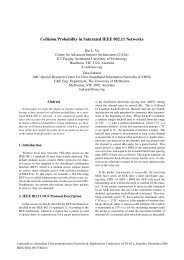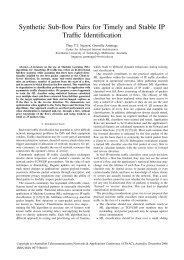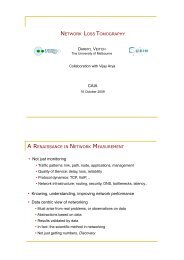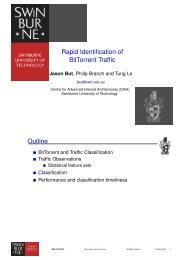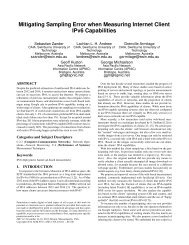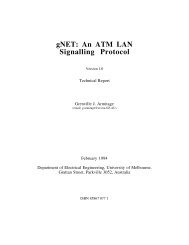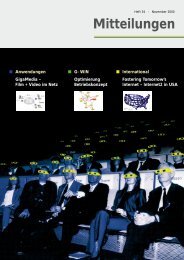Chapter 3 Time-to-live Covert Channels - CAIA
Chapter 3 Time-to-live Covert Channels - CAIA
Chapter 3 Time-to-live Covert Channels - CAIA
You also want an ePaper? Increase the reach of your titles
YUMPU automatically turns print PDFs into web optimized ePapers that Google loves.
Proportion ≤ x<br />
1.0<br />
0.8<br />
0.6<br />
0.4<br />
0.2<br />
0.0<br />
0e+00 2e+05 4e+05 6e+05<br />
Distance between errors (bits)<br />
CHAPTER 3. TIME-TO-LIVE COVERT CHANNELS<br />
Trace AMI<br />
Unif AMI<br />
Trace MED<br />
Unif MED<br />
Proportion ≤ x<br />
1.0<br />
0.8<br />
0.6<br />
0.4<br />
0.2<br />
0.0<br />
0 500 1000 1500<br />
Distance between errors (bits)<br />
Trace AMI<br />
Unif AMI<br />
Trace MED<br />
Unif MED<br />
Figure 3.17: Distance between bit errors in bits for the <strong>CAIA</strong> trace (left) and the Leipzig<br />
trace (right)<br />
Error rate<br />
0.014<br />
0.012<br />
0.010<br />
0.008<br />
0.006<br />
0.004<br />
0.002<br />
0.000<br />
0 200 400 600 800 1000 1200<br />
Window<br />
Error rate<br />
0.14<br />
0.12<br />
0.10<br />
0.08<br />
0.06<br />
0.04<br />
0.02<br />
0.00<br />
0 500 1000 1500 2000 2500<br />
Window<br />
Figure 3.18: Error rate for the MED modulation scheme over consecutive windows of<br />
100 000 bits for the Waika<strong>to</strong> trace (left) and the Leipzig trace (right)<br />
3.5.5 Throughput – trace file analysis<br />
We measured the throughput of the channel using the proposed techniques for reliable<br />
transport and large traffic aggregates with real TTL noise as overt traffic. We simulated<br />
packet loss and reordering since it cannot be deduced from the trace files. We only used<br />
the DED, MED, MED0 and AMI encoding schemes because they perform equal or better<br />
than the other schemes.<br />
Previous studies showed that although some paths experience high loss rates, packet<br />
loss in the Internet is typically ≤ 1% over wired paths [181, 182, 183, 184]. Previous<br />
studies on packet reordering found that it is largely flow and path dependent [182, 185,<br />
186]. For example, Iannacone et al. found that while 1–2% of all packets in the Sprint<br />
backbone were reordered, only 5% of the flows experienced reordering [185].<br />
64



